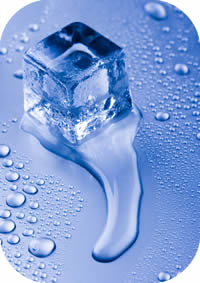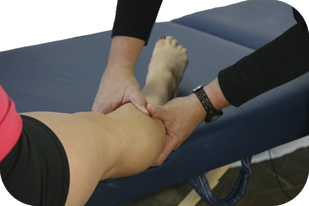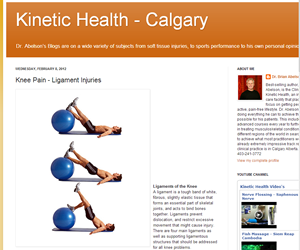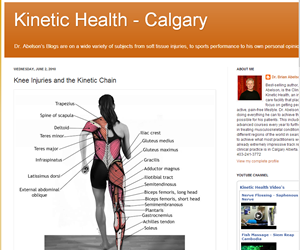Ligament Injuries of the Knee
 Ligamentous injuries to the knee can be debilitating and painful, and are dreaded by athletes.Ligament injuries to the knee occur when the knee joint is twisted, bent sideways, or bent backward. These injuries can range from a small tear in the ligament, to severe injuries where the ligament tears completely away from the bone.
Ligamentous injuries to the knee can be debilitating and painful, and are dreaded by athletes.Ligament injuries to the knee occur when the knee joint is twisted, bent sideways, or bent backward. These injuries can range from a small tear in the ligament, to severe injuries where the ligament tears completely away from the bone.
Ligament injuries to the knee occur when the knee joint is twisted, bent sideways, or bent backward. It can also occur with strong physical contact, such as a tackle in a football game.
Typically, in sports, this injury occurs when the foot is planted firmly in the ground, and sudden force hits your knee while the leg is slightly bent or straight (eg: skiing, football, soccer all have the sudden stop-and-go motions that can cause this type of injury).
There are four main ligaments in the knee which work synergistically to stabilize the joints of the knee:
- Anterior Cruciate Ligament (ACL).
- Posterior Cruciate Ligament (PCL).
- Medial Collateral Ligament (MCL).
- Lateral Collateral Ligament (LCL).
It is important to remember that all these ligaments work synergistically, and independently, to stabilize the knee without the active participation of the surrounding muscles. For example, when your knee is extended, all these ligaments tighten up. However, when your knee is slightly bent, numerous other muscles come into play to stabilize the knee.
Anterior cruciate ligament (ACL) is often injured by a sudden rotational motion of the knee. Cruciate means ‘crossed’. The anterior and posterior ligaments cross each other in the middle of the knee joint. The ACL attaches to the front of the shin bone (the anterior intercondylar area of the tibia) and acts to restrict anterior motion (prevents forward displacement) of the tibia (shin bone) on the femur (leg bone). The ACL works with the muscles in the back of the knee to prevent hyperextension of the knee.
Posterior cruciate ligament (PCL) is often injured by the effects of a direct impact such as might occur in a sporting event, or a motor vehicle impact. This ligament attaches to the back of the shin bone (the posterior intercondylar area of tibia) and works to restrict posterior motion (prevents backward displacement) of the tibia (shin bone) on the femur (leg bone). Squatting actions cause increased stress on the PCL.
Medial collateral ligament (MCL) is often injured by some type of trauma to the outside of the knee. MCL injuries are common in hockey, football, rugby, or other high-contact sports. The MCL runs from the inside of the leg bone (femur) to the inside of the shin bone (upper medial shaft of the femur). This ligament stabilizes the inside (medial side) of the knee joint.
 Lateral collateral ligament (LCL) can be injured by an impact to the inside of the knee. The LCL runs from the outside of the leg bone (femur) to the outer bone just below the knee (head of the fibula). This ligament stabilizes the outside (lateral side) of the knee joint.
Remember, all these ligaments work synergistically and independently to stabilize the knee without the active participation of the surrounding muscles. For example, when your knee is extended, all these ligaments tighten up. However, when your knee is slightly bent, numerous other muscles come into play to stabilize the knee.
Your body maintains a fine balance of structural activity when moving from passive ligament stabilization to active muscle control.
Lateral collateral ligament (LCL) can be injured by an impact to the inside of the knee. The LCL runs from the outside of the leg bone (femur) to the outer bone just below the knee (head of the fibula). This ligament stabilizes the outside (lateral side) of the knee joint.
Remember, all these ligaments work synergistically and independently to stabilize the knee without the active participation of the surrounding muscles. For example, when your knee is extended, all these ligaments tighten up. However, when your knee is slightly bent, numerous other muscles come into play to stabilize the knee.
Your body maintains a fine balance of structural activity when moving from passive ligament stabilization to active muscle control.
Restrictions in either ligament motion or muscle contraction can create a weak link in the kinetic chain. These weak links create motion compensations, friction, inflammation; and cause development of scar tissue, adhesions, or thickening of the tissue.
Resolving Ligament Damage
Your body maintains a fine balance of structural activity when moving from passive ligament stabilization to active muscle control. Restrictions in either ligament motion or muscle contraction can create a weak link in the kinetic chain. These weak links create motion compensations, friction, inflammation; and cause development of scar tissue, adhesions, or thickening of the tissue.
At Kinetic Health, we use a combination of soft-tissue treatments, icing, and specially selected exercises to help resolve our patients ligament injuries.
Click on each of the following tabs for more information about how we work with you to heal your ligament injury.
 Initial Self-Treatment
Initial Self-Treatment
Upon the initial onset of an injury to the ligaments, it is important to:
- Rest – Avoid putting excess stress on the knee. In some cases, if the injury is severe, crutches may be advisable.
- Ice – Use ice on the knee for 20-30 minutes, every 2-3 hours, until the swelling is reduced.
- Elevate – Elevate the knee to help reduce inflammation. Place a rolled up blanket or pillow under the knee.
- Compress – Apply an elastic tensor bandage to the knee to reduce swelling.
Treating Ligament Injuries with ART
ART is a powerful tool for treating ligamentous injuries:
 First, ART can be used to release adhesions between ligaments, muscles, and their surrounding soft tissues. This improves circulatory function, increases blood flow, increases lymphatic flow, and substantially decreases healing time.
First, ART can be used to release adhesions between ligaments, muscles, and their surrounding soft tissues. This improves circulatory function, increases blood flow, increases lymphatic flow, and substantially decreases healing time.
Second, ART can often prevent these conditions from ever arising in the first place. It does this by improving the quality of all the soft tissues affecting the knee. By ‘quality’, I am referring to the muscle’s ability to store and release energy; much like an elastic cord that stretches and releases efficiently – until multiple knots are tied into it. Muscles, much like elastic cords, function extremely well until they build up adhesions from repetitive motion, injury, or muscle imbalances.
Again, as with all injuries, the ART treatments must be accompanied by the appropriate exercise routines to rehabilitate and restore the muscles and tissues of the injured structure’s kinetic chain. Remember, by making your muscles more able to absorb shock, you are reducing the chances of a future ligament injury.
Exercises to Help you Heal
Kinetic Health provides a number of excellent resources that can help you to resolve your knee injuries.
Dr.Abelson’s international best-seller – Release Your Pain – provides a detailed description about the causes of Knee Ligament Injuries. It discusses means for resolving this condition, and provides specially selected exercises to help you begin the process of healing from this condition.
Visit our website at www.releaseyourbody.com to purchase your eBook or hard-copy.
Exercise Videos for Ligament Injuries of the Knee
The following videos by Dr. Abelson provide extra information about Ligamentous injuries of the knee, its kinetic chain, as well as exercises to help resolve this condition. Click on the left and right arrows to scroll through these videos.
- Resolving Knee Pain
- Foam Roller – The Iliotibial band
IT Band or Iliotibial band is a common problem with runners. This foam roller exercise will help to release restrictions in the band that runs from your hip to your knee.
Play Video
Click To Play
- Foam Roller – The Adductors
A groin strain usually refers to a tearing of one of the adductor muscles. This foam roller exercise will help you release restrictions on the inside of your thigh from your knee to your groin.
Play Video
Click To Play
- Foam Roller – The Quadriceps
The quadriceps is a group of four muscles that run along the front of your thigh. This foam roller exercise helps to release restrictions in this group of muscles.
Play Video
Click To Play
- One Leg Split Squat
The one leg split squat or Bulgarian split squat is an excellent exercise for activating the glutes (external hip rotators). Key exercise in rehabing back, hip, knee, ankle and even foot injuries.
Play Video
Click To Play
- Foam Roller – The VMO – Vastus Medialis Obliquus
This foam roller exercise is great for releasing the VMO. VMO stands for Vastus Medialis Oblique (aka. obliquus). The VMO is part of the Vastus Medialis muscle which is one of the four Quadriceps muscles. The VMO stabilizes the patella (knee cap).
Play Video
Click To Play
- Foam Roller – Glute & IT Band
The foam roller is a great way to do a myofascial release of both the glutes and the IT band
Play Video
Click To Play
PreviousNextPreviousNext
Related Blog Articles by Dr. Abelson
Click on the following blog article for additional information on Knee Ligament Injuries.

A ligament is a tough band of white, fibrous, slightly elastic tissue that forms an essential part of skeletal joints, and acts to bind bones together. Ligaments prevent dislocation, and restrict excessive movement that might cause injury.
There are four main ligaments as well as supporting ligamentous structures that should be addressed for all knee problems.

Together these ligaments work synergistically to stabilize the knee joints. For example, if your knee is extended, all of these ligaments tighten up. This stabilization effect does not require, and is independent of, muscle action. In comparison when the knee is slightly bent numerous muscles are required for stabilization.
When dealing with any knee injury, your practitioner should consider all the anatomical structures both above and below the knee. New patterns of dysfunction will develop whenever any segment of the knee’s kinetic chain is not functioning properly.
 Ligamentous injuries to the knee can be debilitating and painful, and are dreaded by athletes.Ligament injuries to the knee occur when the knee joint is twisted, bent sideways, or bent backward. These injuries can range from a small tear in the ligament, to severe injuries where the ligament tears completely away from the bone.
Ligamentous injuries to the knee can be debilitating and painful, and are dreaded by athletes.Ligament injuries to the knee occur when the knee joint is twisted, bent sideways, or bent backward. These injuries can range from a small tear in the ligament, to severe injuries where the ligament tears completely away from the bone.
 Lateral collateral ligament (LCL) can be injured by an impact to the inside of the knee. The LCL runs from the outside of the leg bone (femur) to the outer bone just below the knee (head of the fibula). This ligament stabilizes the outside (lateral side) of the knee joint.
Remember, all these ligaments work synergistically and independently to stabilize the knee without the active participation of the surrounding muscles. For example, when your knee is extended, all these ligaments tighten up. However, when your knee is slightly bent, numerous other muscles come into play to stabilize the knee.
Your body maintains a fine balance of structural activity when moving from passive ligament stabilization to active muscle control.
Lateral collateral ligament (LCL) can be injured by an impact to the inside of the knee. The LCL runs from the outside of the leg bone (femur) to the outer bone just below the knee (head of the fibula). This ligament stabilizes the outside (lateral side) of the knee joint.
Remember, all these ligaments work synergistically and independently to stabilize the knee without the active participation of the surrounding muscles. For example, when your knee is extended, all these ligaments tighten up. However, when your knee is slightly bent, numerous other muscles come into play to stabilize the knee.
Your body maintains a fine balance of structural activity when moving from passive ligament stabilization to active muscle control. Initial Self-Treatment
Initial Self-Treatment


 Knee Injuries and the Kinetic Chain
Knee Injuries and the Kinetic Chain